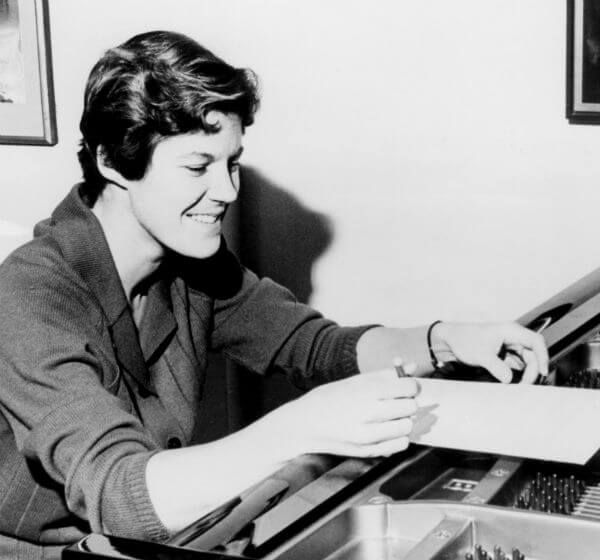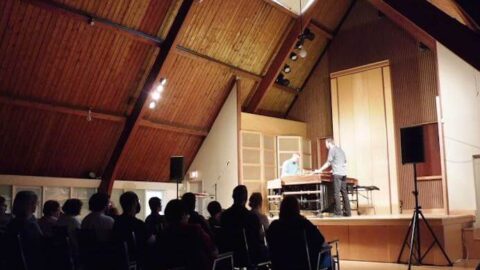On Friday, July 17, 2015, percussion duo Taktus hosted the launch of their CD Glass Houses for Marimba at the 918 Bathurst Centre for Culture, Arts, Media & Education in Toronto. Featuring the live presentation of the CD program interspersed with informal talks by the performers, the event was a celebration of the music of Ann Southam (1937-2010) by way of a newly-arranged presentation of her work.
The audience of 80 included young creators and supporters, as well as the late composer’s brother and those who have been performing her work for decades. There was a sense that this was Southam’s music reaching a new generation in the approving presence of longstanding champions. The resonant all-wood performance space at 918 Bathurst was a hand-in-glove fit for the sound of two five-octave marimbas, amplifying them naturally. There was great warmth in the music, and the audience returned that warmth in kind.
Taktus are Greg Harrison and Jonny Smith. Harrison first heard Glass Houses No. 5 in 2009 and tried to arrange it for solo marimba, quickly discovering it to be nearly impossible to play as a solo. He had success in creating a playable two-marimba version, and through his teacher, percussionist Beverley Johnston, had a chance to meet with Southam and perform the new scoring for her. She loved what she heard and encouraged him to explore the other movements.

Glass Houses (1981) is a landmark in Canadian composition; a nearly two-hour long, 15-movement cycle of minimal piano music that is arguably the late Southam’s signature work. It is a virtuoso work, each movement consisting of fast moving, repeated patterns in the left hand and recurring melodies in the right hand that are metrically independent, constantly shifting against the left hand. The feel of the music is motoric but never mechanical. Southam revised the work shortly before her death, and gave her blessing to a further revision and recording by Christina Petrowska-Quilico, and also to this project in its nascent stage.
The duo performed two movements at Southam’s memorial concerts, being further encouraged by the response. They arranged six movements, all of them heard on this program, taking turns playing either the repeating patterns or the wide-ranging melody. As a result, neither performer seems more prominent than the other; both are interesting to watch. On this evening, they played with a tight, interlocking rhythmic flow, varying dynamics and tempo in perfect ensemble, especially in No. 7. As Harrison told the 918 Bathurst audience, “We’re almost telepathic at this point.”
The tempos in this arrangement are generally slower than the original. This allows for the watery notes of the marimbas to sound distinctly, yet still sustain the clouds of harmony implied in the score. The slower tempos also open the door for new rhythmic possibilities in terms of groove, accent and percussive weight.

This was particularly the case with No. 13, which Harrison described performing as “like being in a djembe circle.” It has a relaxed tempo and spacious feel, reminding me of Steve Reich’s Music for Mallet Instruments, Voices and Organ (1973); which as it happens, is a work Southam adored. She once noted that although Glass Houses makes an intentional reference to Philip Glass in order to identify it as minimalist in style, she found Reich’s percussion-based work more interesting. Glass Houses has the rippling sound of early Glass, but there is something inevitable about this marimba makeover with its hints at Reich’s modularity and use of twin instruments.
No. 8 was heard second to last and provided a peak to the performance. There was sustained, fun energy in the playing and a tonally ambiguous, oh-so-minimalist dominant mode harmony. No. 9 flagged somewhat; yet with some tricky, instrument-spanning runs in the melody it was still a daring and satisfying finale. Overall, the program was well ordered, with the two movements in conventional major keys forming optimistic bookends to the modal, ultimately introspective movements. It was a beautiful union of Southam’s affirmative music and Taktus’ ingenious, light-filled arrangement.
Harrison and Smith formed a casual bond with the audience, coming across as unapologetically nerdy and droll at times (cue iPhone marimba ringtone joke). They invited questions about the program, and in between movements gave a detailed account of the history of the project including the recording of the CD (and planned vinyl LP). With the help of family, friends and colleagues, they organized an event with a welcoming atmosphere and compelling music.
























